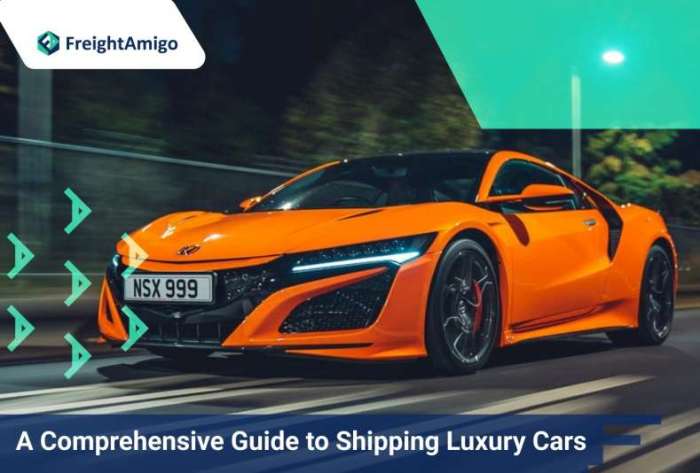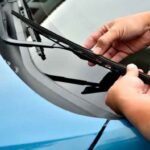How to ship a luxury car internationally? It sounds daunting, right? But with the right planning and knowledge, shipping your prized possession across borders can be surprisingly smooth. This guide breaks down the process, from choosing the best shipping method and preparing your car for the journey to navigating customs and minimizing costs. We’ll cover everything you need to know to ensure your luxury vehicle arrives safely and securely at its destination.
From understanding the nuances of Roll-on/Roll-off versus container shipping to mastering the art of pre-shipment preparation and navigating the complexities of international documentation, this comprehensive guide will equip you with the knowledge and confidence to handle the entire process. We’ll even delve into selecting a reputable shipping company, tracking your shipment, and addressing potential insurance claims – all with a focus on protecting your investment.
Choosing a Shipping Method
Shipping your luxury car internationally requires careful consideration of various factors, most importantly the shipping method. The best option depends on your budget, timeline, and the specific needs of your vehicle. Different methods offer varying levels of cost, speed, security, and suitability for different types of cars. Let’s break down the key choices.
International Auto Shipping Methods Compared
Choosing the right shipping method is crucial for the safe and timely delivery of your luxury car. The table below summarizes the key differences between common methods. Remember that actual costs and transit times can vary widely based on origin, destination, and specific circumstances.
| Shipping Method | Cost | Transit Time | Security | Suitability for Luxury Cars |
|---|---|---|---|---|
| Roll-on/Roll-off (RoRo) | Generally the most affordable | Relatively fast, depending on port schedules | Moderate; susceptible to weather damage and theft | Suitable for most cars, but potentially less secure for high-value vehicles |
| Container Shipping | More expensive than RoRo, but less than specialized transport | Transit time varies but often comparable to RoRo | High; enclosed container offers significant protection from weather and theft | Excellent for luxury cars, offering maximum protection |
| Specialized Auto Transport | Most expensive option | Transit time can be faster than RoRo or container, depending on route | High; vehicles are often individually monitored and transported on specialized carriers | Ideal for high-value or highly specialized luxury cars requiring extra care |
Pros and Cons of Each Shipping Method
Each shipping method presents a unique set of advantages and disadvantages. Understanding these trade-offs is critical for making an informed decision.
Roll-on/Roll-off (RoRo):
Pros: Cost-effective, relatively fast transit times. Cons: Lower security compared to other methods, potential for weather damage, less protection against theft.
Container Shipping:
Pros: High security, excellent protection from weather and theft, suitable for various car types. Cons: More expensive than RoRo, loading and unloading can be time-consuming.
Specialized Auto Transport:
Pros: Highest level of security and care, often faster transit times, ideal for high-value vehicles. Cons: Most expensive option.
Insurance Options for International Car Shipping
Adequate insurance is essential when shipping a luxury car internationally. Coverage levels vary significantly between providers and shipping methods. It’s crucial to carefully review the policy terms before selecting a provider.
Generally, insurance options include:
Basic Coverage: This typically covers damage or loss due to accidents during transit, but may exclude certain types of damage or theft. Deductibles usually apply.
Comprehensive Coverage: Offers broader protection, including coverage for theft, vandalism, and other incidents not covered by basic policies. Premiums are higher than basic coverage.
Optional Add-ons: Many insurers offer optional add-ons, such as coverage for specific components (e.g., custom rims, high-end audio systems), or coverage for delays.
The specific insurance options and coverage levels will vary depending on the chosen shipping method and the insurer. It is advisable to compare quotes from multiple insurers before making a decision.
Preparing Your Luxury Car for Shipment
Shipping your luxury car internationally is a big deal, and proper preparation is key to ensuring it arrives safely at its destination. Think of it like packing for a really, really long road trip – you wouldn’t just toss your prized possessions in the backseat, would you? This section Artikels the crucial steps to get your vehicle ready for its overseas journey.
Neglecting these steps could lead to costly damage or delays.Preparing your luxury car for international shipment involves several key steps to protect its value and condition during transit. These preparations will minimize the risk of damage and ensure a smooth arrival at your destination. The process requires attention to detail and careful execution.
Pre-Shipment Checklist for Luxury Cars
Before your car even sees the inside of a shipping container, you need a solid plan. This checklist covers essential pre-shipment preparations to ensure your car is properly protected. A thorough preparation significantly reduces the risk of damage or loss during transit.
- Thorough Cleaning: Wash and detail your car inside and out. Remove all loose items, trash, and personal belongings. A clean car is easier to inspect for pre-existing damage and makes it less susceptible to damage during transit.
- Document Existing Damage: Take detailed photographs and videos of any existing scratches, dents, or imperfections, both interior and exterior. Timestamp and date these images. This documentation serves as proof of pre-existing condition and prevents disputes later.
- Secure Valuable Items: Remove any valuable items from the car, such as custom stereo systems, aftermarket parts, or anything not factory-installed. These items are best transported separately and insured individually.
- Check Fluids: Check all fluids (oil, coolant, brake fluid, power steering fluid, windshield washer fluid) and top them off to recommended levels. This prevents leaks and potential damage during transit. Consider using a fuel stabilizer if the car will be in storage for an extended period.
- Empty the Fuel Tank: It’s generally recommended to have less than a quarter tank of fuel to reduce the risk of fuel spillage or vapor buildup during transit. This is a safety precaution for both the car and the shipping process.
Disconnecting and Preparing the Car Battery
Leaving your car battery connected during a long-distance shipment can lead to battery drain and potential damage to the car’s electrical system. This section provides a step-by-step guide for safely disconnecting the battery.
- Gather Supplies: You’ll need a wrench or socket that fits your battery terminals, and some masking tape or electrical tape.
- Disconnect the Negative Terminal: Locate the negative terminal (usually marked with a “-” symbol). Loosen the terminal nut and carefully disconnect the cable. Tape the disconnected end to prevent accidental contact.
- Disconnect the Positive Terminal: Repeat the process for the positive terminal (usually marked with a “+” symbol). Again, tape the disconnected end.
- Secure the Terminals: Once disconnected, secure the terminals to prevent them from moving or shorting during transit. This is crucial to avoid electrical damage.
Protecting the Car’s Interior and Exterior
Protecting your car’s interior and exterior is critical for preserving its condition during transit. The following best practices will help to minimize the risk of damage during shipping.
- Exterior Protection: Consider using a protective car cover designed for shipping. This helps shield the paint from scratches and debris. For added protection, you might use foam padding to protect vulnerable areas like headlights and bumpers.
- Interior Protection: Cover the interior surfaces with blankets or towels to protect against scratches and dust. Use seat covers or bubble wrap to protect leather or other delicate materials. Consider using steering wheel and gear shift covers to prevent wear.
- Wheel Protection: Inflate tires to the manufacturer’s recommended pressure. You may also consider using wheel chocks to prevent movement during transit. This helps maintain the correct tire pressure and prevents damage to the wheels.
Documentation and Legal Requirements: How To Ship A Luxury Car Internationally
Shipping a luxury car internationally isn’t just about loading it onto a ship; it’s a complex process involving a mountain of paperwork and navigating various legal hurdles. Getting this right is crucial to avoid delays, hefty fines, and potential seizure of your vehicle. Accuracy and thoroughness are paramount at every stage.Preparing the necessary documentation can seem daunting, but understanding the key requirements will streamline the process.
This section details the essential paperwork and legal considerations for successfully shipping your luxury car across borders.
Export Permits
Obtaining an export permit is usually the first step. This document certifies that the vehicle’s export complies with your country’s regulations. The specific requirements vary widely depending on your country of origin. For example, the United States might require a bill of sale and proof of ownership, while other countries may have more stringent processes. It’s essential to contact your country’s customs authorities or a specialized export agent well in advance to understand the exact requirements and allow ample time for processing.
So you’re thinking about shipping your sweet ride internationally? Figuring out the logistics can be a total headache, especially with a luxury car. But first, you gotta pick the perfect car! Check out this list of the Best luxury convertibles for summer 2025 to get some inspiration before you start planning your international shipping. Once you’ve chosen your dream convertible, you can focus on finding a reputable shipper to get it where it needs to go.
Delays in obtaining this crucial document can significantly impact your shipping timeline.
Customs Declarations, How to ship a luxury car internationally
Customs declarations are vital for informing the destination country’s customs authorities about the vehicle. These forms require detailed information about the car, including its make, model, year, VIN (Vehicle Identification Number), and engine specifications. You’ll also need to declare its value accurately, which is crucial for determining import duties and taxes. Inaccuracies can lead to delays, penalties, and even confiscation.
For example, undervaluing your car to avoid taxes is a serious offense with severe consequences. A complete and accurate customs declaration significantly reduces the risk of complications. A common example of information needed is a detailed description of the car’s condition, including any existing damage.
Insurance Certificates
Comprehensive insurance coverage is essential to protect your investment during transit. This should cover potential damage, loss, or theft during shipping. The insurance certificate should clearly state the policy details, coverage limits, and the duration of the coverage, ensuring it extends throughout the entire shipping process. Make sure your insurance policy explicitly covers international shipments and specifies the type of transport being used.
The certificate serves as proof of insurance and is often required by both the shipping company and the destination country’s customs authorities. It’s wise to choose a reputable insurer specializing in international vehicle transport.
Import Duties and Taxes
Import duties and taxes vary considerably between countries. These are essentially fees levied by the importing country on the value of the vehicle. Factors influencing these costs include the car’s value, its age, engine size, and the specific import regulations of the destination country. For example, importing a luxury car into the European Union might involve VAT (Value Added Tax) and potentially other import duties.
Researching the specific import regulations of your destination country well in advance is crucial for budgeting accurately and avoiding unexpected costs. Failing to account for these fees can lead to significant financial surprises upon arrival. Consulting a customs broker familiar with the destination country’s regulations can provide valuable assistance in estimating and managing these costs.
Selecting a Reputable Shipping Company

Choosing the right international car shipping company is crucial for a smooth and stress-free experience. A bad choice can lead to delays, damage, and unexpected costs. This section will guide you through selecting a reputable partner capable of handling your luxury vehicle’s international journey.Selecting a reputable international car shipping company requires careful consideration of several key factors. Finding a company with a proven track record of safe and efficient transport is paramount to protect your valuable asset.
Criteria for Selecting a Reliable International Car Shipping Company
Choosing the right shipper involves more than just the cheapest quote. Consider these essential criteria to ensure a safe and reliable transport experience for your luxury car.
- Licensing and Insurance: Verify that the company possesses all necessary licenses and insurance coverage, including comprehensive cargo insurance to protect against damage or loss during transit. This protects your investment in case of unforeseen events.
- Experience and Reputation: Look for companies with extensive experience in shipping luxury vehicles internationally. Check online reviews and testimonials from previous clients to gauge their reputation and level of customer service. A long history of positive feedback speaks volumes.
- Tracking and Communication: A reputable company will provide real-time tracking of your vehicle’s location and offer clear, consistent communication throughout the shipping process. Regular updates keep you informed and alleviate anxiety.
- Specialized Handling: Ensure the company specializes in handling luxury cars and understands the unique needs of transporting high-value vehicles. This includes secure handling, climate-controlled transport (if needed), and appropriate security measures.
- Clear Pricing and Contract: Avoid companies with hidden fees or unclear pricing structures. A transparent contract outlining all costs, responsibilities, and liabilities is essential. This safeguards you from unexpected expenses.
Comparison of Shipping Company Services
Different types of shipping companies offer varying services and levels of specialization. Understanding these differences is key to making an informed decision.Freight forwarders act as intermediaries, coordinating the logistics and arranging transportation with various carriers. They may offer competitive pricing but may lack the specialized expertise of dedicated auto transport companies. Specialized auto transport companies, on the other hand, focus solely on vehicle shipping and often provide more personalized service and specialized handling for luxury cars, including potentially climate-controlled transport.
They often have dedicated staff with expertise in handling high-value vehicles. The choice depends on your priorities; cost-effectiveness versus specialized care.
Questionnaire for Assessing Shipping Company Trustworthiness and Expertise
A structured questionnaire can help you systematically assess potential shipping partners.
| Question Area | Specific Questions |
|---|---|
| Company Background | How long has your company been in operation? Can you provide references from previous clients shipping luxury vehicles? What are your licensing and insurance details? |
| Shipping Process | Describe your process for securing and transporting luxury vehicles. What security measures do you employ? How do you handle potential damage or delays? What type of tracking system do you use? |
| Pricing and Contract | Provide a detailed breakdown of all costs involved. What are your liability limits? What is your cancellation policy? |
| Customer Service | How can I contact you in case of emergencies or questions? What is your typical response time to inquiries? Can you provide examples of how you have handled previous customer issues? |
Tracking and Insurance Claims
Shipping a luxury car internationally is a significant undertaking, and staying informed throughout the process is crucial. Knowing how to track your vehicle’s journey and what steps to take in case of unforeseen issues will significantly reduce stress and potential financial losses. This section details the procedures for tracking your shipment and filing an insurance claim if necessary.
Effective tracking and a robust insurance plan are essential for peace of mind. Understanding these processes beforehand allows you to proactively address any complications that may arise.
Shipment Tracking Procedures
Maintaining consistent communication with your shipping company is key to tracking your car’s progress. Most reputable companies provide online tracking portals with real-time updates. These portals typically use a unique tracking number assigned to your shipment at the beginning of the process.
- Obtain your tracking number: This unique identifier is provided by your shipping company once your car is picked up and registered for shipment. It’s often emailed to you or available on your online account.
- Access the tracking portal: The shipping company’s website will have a dedicated section for tracking shipments. Enter your tracking number to view the current status and location of your vehicle.
- Regularly check for updates: Check the tracking portal regularly, ideally once or twice a day, to monitor your car’s progress. This allows you to stay informed about any potential delays or changes in its itinerary.
- Understand the stages of shipment: Familiarize yourself with the typical stages involved in international car shipping, such as pickup, port processing, ocean voyage (if applicable), customs clearance, and final delivery. This will help you interpret the tracking information more effectively.
- Contact the shipping company if needed: If you notice any discrepancies in the tracking information or if there are significant delays, contact your shipping company immediately to inquire about the situation.
Filing an Insurance Claim
Comprehensive insurance is vital when shipping a luxury vehicle internationally. It protects against potential damage, loss, or theft during transit. Understanding the claims process before any incident occurs is advisable.
- Review your insurance policy: Carefully review your insurance policy to understand the coverage, the claims process, and any necessary documentation. Note the required timeframe for reporting a claim.
- Report the damage or loss immediately: As soon as you discover any damage or loss to your vehicle, contact your shipping company and your insurance provider immediately. Prompt reporting is crucial for a smoother claims process.
- Gather necessary documentation: Collect all relevant documentation, including the shipping contract, insurance policy, photos or videos of the damage, and any communication with the shipping company. Thorough documentation strengthens your claim.
- Complete the claim form: Complete the claim form provided by your insurance company accurately and thoroughly. Provide all requested information and supporting documentation.
- Follow up on your claim: After submitting your claim, follow up with your insurance provider to check on its progress. Maintain a record of all communication related to your claim.
Communicating with the Shipping Company
Open and consistent communication with your shipping company is paramount throughout the entire process. Knowing how to effectively communicate concerns or issues can prevent misunderstandings and expedite resolutions.
So you’re thinking about shipping your sweet ride internationally? Getting your luxury car overseas involves a ton of logistics, from finding a reputable shipper to navigating customs. Once you get it there, though, you’ll want to consider registration costs, which is why checking out this list of Cheapest states to register a luxury car is a smart move.
Then, you can focus on the final steps of getting your car on the road in your new location.
Maintain detailed records of all communication, including dates, times, and the names of individuals you’ve spoken with. This documentation is invaluable if disputes arise. Consider using email for important communication, as it provides a written record of your interactions.
Import Regulations and Customs Clearance

Navigating international shipping for luxury cars extends beyond simply getting your vehicle onto a ship; the complexities of import regulations and customs clearance in your destination country are crucial. These processes vary significantly depending on the specific country and its trade agreements, making thorough preparation essential to avoid delays and unexpected costs. Understanding these regulations upfront saves time, money, and potential headaches.The import process for luxury cars generally involves several key steps: providing accurate documentation, paying applicable duties and taxes, and satisfying any specific requirements the destination country may have.
Failing to comply with these regulations can lead to delays, fines, and even the vehicle being refused entry. This section will Artikel common challenges and provide strategies for smooth customs clearance.
Import Regulations Vary by Country
Import regulations for luxury cars differ significantly across countries. For instance, the European Union has relatively standardized procedures, but individual member states may still have specific requirements. The United States has its own complex system, involving the Department of Transportation (DOT) and the Environmental Protection Agency (EPA), in addition to standard customs procedures. Countries like Japan or Australia may have stricter emissions standards or import quotas, requiring specialized documentation and potentially longer processing times.
Understanding the specific requirements of your target country is paramount. A thorough research of the destination country’s customs website is the first step. Additionally, consulting with a customs broker experienced in handling luxury vehicle imports can provide invaluable insights and streamline the process.
Documentation for Customs Clearance
Preparing the necessary documentation is vital for a smooth customs clearance process. This typically includes the vehicle’s title or registration, a bill of sale, a commercial invoice, and a packing list. Additional documents may be required depending on the destination country, such as a certificate of origin, proof of insurance, and import permits. For example, importing a classic car might necessitate documentation verifying its authenticity and age.
Furthermore, some countries require specialized certifications related to emissions compliance or safety standards. Failure to provide complete and accurate documentation can result in significant delays and additional fees. It’s recommended to compile all required documents well in advance and have them properly translated if necessary.
Import Duties, Taxes, and Other Fees
Import duties, taxes, and other fees are significant expenses associated with importing a luxury car. These costs vary considerably based on the vehicle’s value, make, model, age, engine size, and the destination country’s regulations. For example, a high-end sports car imported into the United States will likely face substantial import duties and taxes compared to a used family sedan imported into Canada.
These fees are often calculated as a percentage of the vehicle’s declared value, and additional taxes like VAT (Value Added Tax) or GST (Goods and Services Tax) may also apply. Accurate valuation of the vehicle is crucial to avoid disputes with customs officials. It’s advisable to obtain a professional appraisal to ensure the declared value aligns with market standards.
Furthermore, it is crucial to factor in potential storage fees and other administrative charges that may arise during the customs clearance process. These unforeseen costs can significantly impact the overall cost of importing a luxury vehicle.
Cost Considerations
Shipping a luxury car internationally is a significant investment, and understanding the associated costs is crucial for budgeting and planning. The total expense can vary dramatically based on several factors, so careful consideration is essential to avoid unexpected financial burdens. This section breaks down the typical cost components and offers strategies for minimizing expenses without compromising the safety and condition of your vehicle.
Shipping Fees
Shipping fees are the most substantial component of international luxury car transport. These fees are influenced by the distance the car needs to travel, the chosen shipping method (roll-on/roll-off, container shipping, or specialized transport), and the size and weight of the vehicle. For example, shipping a high-end sedan from the US to Europe via RoRo will generally be cheaper than air freighting a large SUV to Australia.
Factors like fuel surcharges and port fees also contribute to the final shipping cost. It’s common for shipping quotes to be provided as a range, allowing for fluctuations in fuel prices and potential unforeseen circumstances. Getting multiple quotes from different reputable shippers is recommended to find the best possible rate.
Insurance
Comprehensive insurance is vital to protect your valuable asset during transit. This covers potential damage, theft, or loss during the shipping process. The cost of insurance is usually calculated as a percentage of the car’s value. For luxury vehicles, this percentage might be higher due to the increased risk and replacement cost. It’s important to carefully review the insurance policy’s terms and conditions to understand what is and isn’t covered.
Opting for a higher coverage level provides greater peace of mind, though it will increase the overall cost. Consider the value of your vehicle and the risks associated with international shipping when determining your insurance needs.
Customs Duties and Taxes
Import duties and taxes are levied by the destination country and vary significantly based on the vehicle’s value, make, model, and the specific import regulations of that country. These fees can add a substantial amount to the overall cost, sometimes exceeding the shipping fees themselves. Researching the specific import regulations and anticipated duties for your destination country well in advance is crucial.
Working with a customs broker can help navigate this complex process and potentially minimize these costs through proper documentation and efficient customs clearance. Failing to account for these fees can lead to unexpected delays and financial penalties.
Other Potential Expenses
Beyond the primary costs, several other expenses might arise. These include: preparation costs (such as detailing, draining fluids, or securing the vehicle), pre-shipment inspections, terminal handling fees, document processing fees, and potential storage charges if there are delays. It’s prudent to factor in a buffer for unforeseen expenses to avoid budget overruns. A detailed breakdown of all potential costs from the shipping company upfront can help in better financial planning.
Consider the potential need for specialized transport if your vehicle requires specific handling or has unique features.
Minimizing Shipping Costs
While minimizing costs, it’s paramount to maintain the vehicle’s security and condition. Consider these strategies: Shipping during off-peak seasons can often result in lower rates. Choosing the most economical shipping method appropriate for your vehicle is key; RoRo is typically less expensive than container shipping. Negotiating with multiple shipping companies can help secure a more favorable price.
Finally, careful planning and preparation can help minimize potential delays and additional charges. For example, ensuring all necessary documentation is in order can prevent costly delays in customs clearance.
Last Point
Shipping a luxury car internationally doesn’t have to be a stressful experience. By carefully considering the various factors Artikeld in this guide – from choosing the right shipping method and preparing your vehicle properly to navigating the legal and logistical hurdles – you can ensure a safe and efficient transport for your valuable asset. Remember, thorough planning and selecting a reliable shipping partner are key to a successful international car shipment.
So, get ready to embark on your global automotive adventure!









